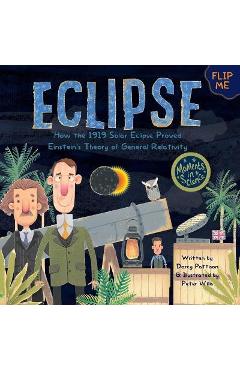
In 1915, British astronomer Arthur Stanley Eddington was fascinated with Einsteins new theory of general relativity.
The theory talks about how forces push and pull objects in space.
Einstein said that the suns gravity could pull and bend light.
To test this, astronomers decided to photograph the 1919 solar eclipse .
The eclipse would allow them to photograph the stars before and during the solar eclipse.
If the stars position moved, then it was evidence that that light had bent.
Eddington and his team traveled from England to the island of Principe, just off the African coast, to photograph the eclipse.
In simple language, this nonfiction illustrated picture book explains how the push (acceleration) and pull (gravity) of space affects light.
Back matter includes information on Einstein, Eddington, and the original photograph of the 1919 solar eclipse.
The text of the book is wonderfully clear and easy to follow, and the illustrations are great, both lively and informative.
The story of the eclipse unfolds dramatically, and the science is explained vividly and correctly.
Daniel John Kennefick, Astrophysicist and Science Historian MOMENTS IN SCIENCE COLLECTION This exciting series focuses on small moments in science that made a difference.
BURN: Michael Faradays Candle CLANG Ernst Chladnis Sound Experiments (2019 NSTA Outstanding Science Trade Book) POLLEN: Darwins 130 Year Prediction (Junior Library Guild selection, starred Kirkus review) ECLIPSE: How the 1919 Eclipse Proved Einsteins Theory of General Relativity (Fall, 2019).
Moor Educational Publishers
78.07 Lei
Clark Ashton Smith
111.60 Lei
W. J. Becker
167.35 Lei
Alexandre Lebreton
297.60 Lei
Federico Vinciolo
61.10 Lei
Harriette Taylor Treadwell
88.91 Lei
Betty Reynolds
94.81 Lei
Margaret Renkl
100.44 Lei
Kevin Wayne Johnson
139.22 Lei
Paramahansa Yogananda
61.10 Lei